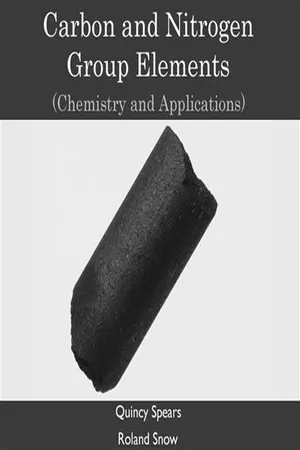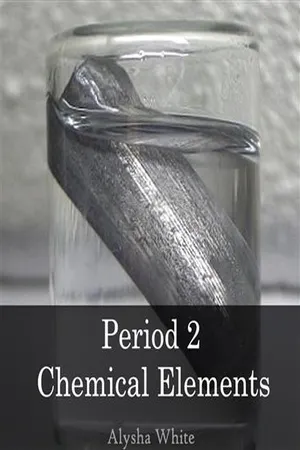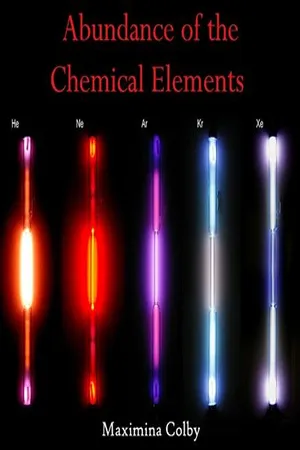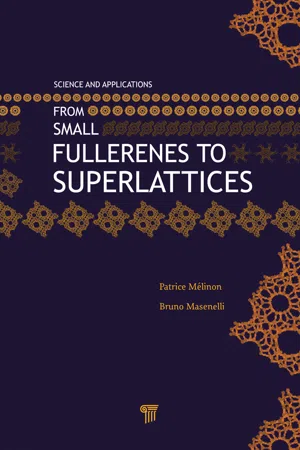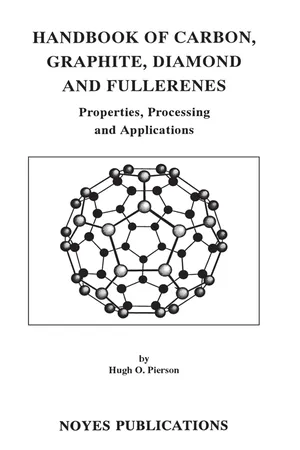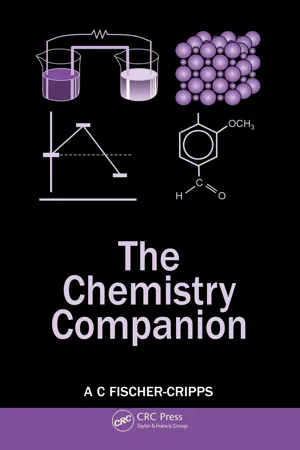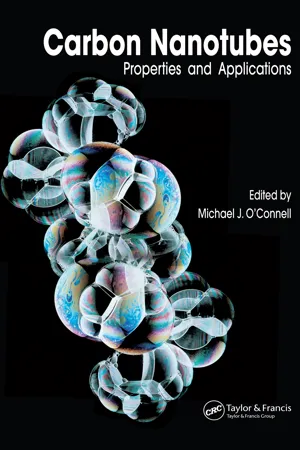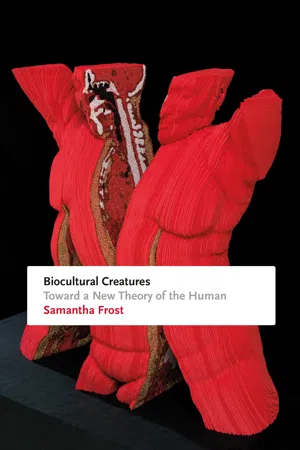Chemistry
Carbon
Carbon is a chemical element with the symbol C and atomic number 6. It is a non-metal with diverse forms, including graphite and diamond. Carbon is known for its ability to form strong covalent bonds with other elements, making it essential for the chemistry of life and the basis of organic chemistry.
Written by Perlego with AI-assistance
Related key terms
1 of 5
12 Key excerpts on "Carbon"
- No longer available |Learn more
- (Author)
- 2014(Publication Date)
- Academic Studio(Publisher)
As a member of group 14 on the periodic table, it is nonmetallic and tetravalent—making four electrons available to form covalent chemical bonds. There are three naturally occurring isotopes, with 12 C and 13 C being stable, while 14 C is radioactive, decaying with a half-life of about 5730 years. Carbon is one of the few elements known since antiquity. The name Carbon comes from Latin carbo , coal. There are several allotropes of Carbon of which the best known are graphite, diamond, and amorphous Carbon. The physical properties of Carbon vary widely with the allotropic form. For example, diamond is highly transparent, while graphite is opaque and black. Diamond is among the hardest materials known, while graphite is soft enough to form a streak on paper (hence its name, from the Greek word to write). Diamond has a very low electrical conductivity, while graphite is a very good conductor. Under normal conditions, diamond has the highest thermal conductivity of all known materials. All the allotropic forms are solids under normal conditions but graphite is the most thermo-dynamically stable. ____________________ WORLD TECHNOLOGIES ____________________ All forms of Carbon are highly stable, requiring high temperature to react even with oxygen. The most common oxidation state of Carbon in inorganic compounds is +4, while +2 is found in Carbon monoxide and other transition metal Carbonyl complexes. The largest sources of inorganic Carbon are limestones, dolomites and Carbon dioxide, but significant quantities occur in organic deposits of coal, peat, oil and methane clathrates. Carbon forms more compounds than any other element, with almost ten million pure organic compounds described to date, which in turn are a tiny fraction of such compounds that are theoretically possible under standard conditions. Carbon is the 15th most abundant element in the Earth's crust, and the fourth most abundant element in the universe by mass after hydrogen, helium, and oxygen. - eBook - PDF
Carbon Nanomaterials
Synthesis, Structure, Properties and Applications
- Rakesh Behari Mathur, Bhanu Pratap Singh, Shailaja Pande(Authors)
- 2016(Publication Date)
- Taylor & Francis(Publisher)
1 1 Introduction to Carbon and Carbon Nanomaterials 1.1 Introduction Carbon is the fifteenth most abundant element in the earth’s crust, and the fourth most abundant element in the universe by mass after hydrogen, helium, and oxygen. Carbon is also present as a major component in large masses of Carbonate rocks, including limestone, dolomite, and marble. Coal is the largest commercial source of mineral Carbon, accounting for nearly 8 billion tons or almost 80% of fossil Carbon fuel. In its elemental form, Carbon (C, atomic number 6) has a valency of 4 and is therefore placed in group IV of the periodic table along with Si, Ge, Sn, and Pb. Carbon can exist in both crystalline and amorphous forms. Figure 1.1 shows the three crystalline allotropes of Carbon, that is, with same chemical properties but with different physical forms. All Carbon allotropes are solids under normal conditions, with graphite being the most thermodynamically stable form. In reality all the allotropes of amorphous Carbons are made of microcrystals of graphite arranged in an irregular fashion. Diamond, graphite, and fullerenes are crystalline allotropes of Carbon. The Carbon atoms in diamond have a three-dimensional (3D) tetrahedral network of covalent bonds, which causes the electrons to be held tightly. Diamonds are therefore very hard and have high melting and boiling points. The structure is a closely packed structure and causes diamond to be denser than graphite. Since all its electrons end up in forming the covalent bonds, therefore it does not conduct electricity. In graphite only three of the four valence electrons of each Carbon atom are used in bonding, leaving the fourth valence electron as free. Therefore graphite is a good conductor of electricity. Diamond is transparent because it has no free electron to absorb radiations and make a transition in the optical region. - No longer available |Learn more
- (Author)
- 2014(Publication Date)
- Library Press(Publisher)
Carbon forms more compounds than any other element, with almost ten million pure organic compounds described to date, which in turn are a tiny fraction of such compounds that are theoretically possible under standard conditions. Carbon is the 15th most abundant element in the Earth's crust, and the fourth most abundant element in the universe by mass after hydrogen, helium, and oxygen. It is present in all known lifeforms, and in the human body Carbon is the second most abundant element by mass (about 18.5%) after oxygen. This abundance, together with the unique diversity of organic compounds and their unusual polymer-forming ability at the temperatures commonly encountered on Earth, make this element the chemical basis of all known life. Characteristics Theoretically predicted phase diagram of Carbon ________________________ WORLD TECHNOLOGIES ________________________ The different forms or allotropes of Carbon (see below) include the hardest naturally occurring substance, diamond, and also one of the softest known substances, graphite. Moreover, it has an affinity for bonding with other small atoms, including other Carbon atoms, and is capable of forming multiple stable covalent bonds with such atoms. As a result, Carbon is known to form almost ten million different compounds; the large majority of all chemical compounds. Carbon also has the highest melting and sublimation point of all elements. At atmospheric pressure it has no melting point as its triple point is at 10.8 ± 0.2 MPa and 4600 ± 300 K, so it sublimates at about 3900 K. Carbon sublimes in a Carbon arc which has a temperature of about 5800 K. Thus, irrespective of its allotropic form, Carbon remains solid at higher temperatures than the highest melting point metals such as tungsten or rhenium. Although thermodynamically prone to oxidation, Carbon resists oxidation more effectively than elements such as iron and copper that are weaker reducing agents at room temperature. - No longer available |Learn more
- (Author)
- 2014(Publication Date)
- Learning Press(Publisher)
Carbon forms more compounds than any other element, with almost ten million pure organic compounds described to date, which in turn are a tiny fraction of such compounds that are theoretically possible under standard conditions. ______________________________ WORLD TECHNOLOGIES ______________________________ Carbon is the 15th most abundant element in the Earth's crust, and the fourth most abundant element in the universe by mass after hydrogen, helium, and oxygen. It is present in all known life forms, and in the human body Carbon is the second most abundant element by mass (about 18.5%) after oxygen. This abundance, together with the unique diversity of organic compounds and their unusual polymer-forming ability at the temperatures commonly encountered on Earth, make this element the chemical basis of all known life. Characteristics Theoretically predicted phase diagram of Carbon The different forms or allotropes of Carbon (see below) include the hardest naturally occurring substance, diamond, and also one of the softest known substances, graphite. Moreover, it has an affinity for bonding with other small atoms, including other Carbon atoms, and is capable of ______________________________ WORLD TECHNOLOGIES ______________________________ forming multiple stable covalent bonds with such atoms. As a result, Carbon is known to form almost ten million different compounds; the large majority of all chemical compounds. Carbon also has the highest melting and sublimation point of all elements. At atmospheric pressure it has no melting point as its triple point is at 10.8 ± 0.2 MPa and 4600 ± 300 K, so it sublimates at about 3900 K. Carbon sublimes in a Carbon arc which has a temperature of about 5800 K. Thus, irrespective of its allotropic form, Carbon remains solid at higher temperatures than the highest melting point metals such as tungsten or rhenium. - eBook - PDF
- Anke Krüger(Author)
- 2010(Publication Date)
- Wiley-VCH(Publisher)
Comments and suggestions to improve future editions of the text are highly welcome; still I wish that all readers of this book may have fun and gain knowledge while discovering the many facets of Element 6. Kiel, January 2010 Anke Krueger 1 Carbon – Element of Many Faces The sixth in the periodic table of elements is, at the same time, among the most important ones. With about 180 ppm, Carbon is only 17th on the list of terrestrial elements’ frequency, situated even after barium or sulfur – for comparison, the second-most frequent element, silicon, is about 1300 times as abundant as Carbon. Still the latter is essential for the assembly of all organic matter. It is predestined for this central role especially due to its mid position in the periodic system and its associated ability to form stable substances with more electropositive and more electronegative reaction partners. Yet in the present text the organic chemistry resulting from these various bonding possibilities will only be mentioned if it is employed to modify Carbon materials or, to put it in other words, the element itself as a material will be in the focus. Another feature that gave reason to write this book was the occurrence of various allotrope modifications with in parts completely opposite properties. For the time being, this renders Carbon one of the most interesting topics in materials science and research. Be it fullerenes, nanotubes or nanocrystalline diamond phases – they all are subject to intensive investigation and promise a multitude of applications, for example, in electronics, medicine, and nanotechnology. Nevertheless, it is hardly possible to assess the development within the last two decades and to perceive its impact on the multitalented Carbon’s perspectives in chemistry, material science, and physics, without an understanding of its long- known modifications, mainly graphite and diamond. - eBook - PDF
From Small Fullerenes to Superlattices
Science and Applications
- Patrice Melinon, Bruno Masenelli, Patrice Melinon, Bruno Masenelli(Authors)
- 2012(Publication Date)
- Jenny Stanford Publishing(Publisher)
Chapter 2 Carbon Properties 2.1 Introduction 2.1.1 Carbon Atom Without the element Carbon, life as we know it would not exist. In this sense, this is one of the most important elements. Pure Carbon has extremely low toxicity and can be handled and even ingested safely. It is the fourth most abundant element in the universe by mass after hydrogen, helium, and oxygen but amounts to less than 0.1% in the earth crust. However, few millions of compounds, including Carbon, are reported and synthesized regularly. Carbon has six electrons. Two of them will be found in the 1 s orbital close to the nucleus, the next two going into the 2 s orbital. The remaining ones will be in two separate 2 p orbitals. The electronic structure of Carbon is normally written in the form 1 s 2 2 s 2 2 p 1 x 2 p 1 y or more commonly 1 s 2 2 s 2 2 p 2 because the p orbitals have the same energy. Table 2.1 gives the first transition observed in the excited state (2 s 2 2 p 2 to 2 s 2 p 3 ). For the sake of comparison, the same transition energy is given for all group IV elements. From a chemical point of view, the Carbon atom has a compact core formed by the two inner shell 1 s electrons and four valence electrons participating to the chemical bonding in compounds From Small Fullerenes to Superlattices: Science and Applications Patrice M´ elinon and Bruno Masenelli Copyright c 2013 Pan Stanford Publishing Pte. Ltd. ISBN 978-981-4241-84-7 (Hardcover), 978-981-4267-92-2 (eBook) www.panstanford.com 8 Carbon Properties Table 2.1. s – p and s – d promotion energies for the elements of the column IVA. The limit corresponding to the first ionization potential is also reported. In the case of lead, the s – p promotion is not observed below the potential threshold. - eBook - PDF
Handbook of Carbon, Graphite, Diamonds and Fullerenes
Processing, Properties and Applications
- Hugh O. Pierson(Author)
- 2012(Publication Date)
- William Andrew(Publisher)
The compounds of Carbon and hydrogen and their derivatives form the extremely large and complex branch of chemistry known as organic chemistry . More than half-a-million organic compounds are identified and new ones are continuously discov-ered. In fact, far more Carbon compounds exist than the compounds ofall other elements put together.£1 1 While organic chemistry is not a subject of this book, it cannot be overlooked since organic compounds playa major part in the processing of Carbon polymorphs. Some examples of organic precursors are shown in Table 2.1.1 2 1 Table 2.1. Organic Precursors of Carbon Products Precursors Methane HydroCarbons FluoroCarbons Acetone, etc. Rayon Polyacrylonitrile Phenolics Furfuryl alcohol Petroleum fractions Coal tar pitch Plants Products Pyrolytic graphite Diamond-like Carbon Polycrystalline diamond Carbon fibers Carbon-Carbon Vitreous Carbon Molded graphites Carbon fibers Coal The Element Carbon 13 In order to understand the formation of the allotropes of Carbon from these precursors and the reasons for their behavior and properties, it is essential to have a clear picture of the atomic configuration of the Carbon atom and the various ways in which it bonds to other Carbon atoms. These are reviewed in this chapter. 1.2 The Structure ofthe Carbon Atom All atoms have a positively charged nucleus composed of one or more protons, each with a positive electrical charge of + 1, and neutrons which are electrically neutral. Each proton and neutron has a mass of one and together account for practically the entire mass of the atom. The nucleus is surrounded by electrons, rnovinq around the nucleus, each with a negative electrical charge of -1. The numberof electrons is the same as the number of protons so that the positive charge of the nucleus is balanced by the negative charge of the electrons and the atom is electrically neutral. - eBook - PDF
- Anthony C. Fischer-Cripps(Author)
- 2011(Publication Date)
- CRC Press(Publisher)
11 Carbon Chemist 11. Carbon Chemistry 11 . Carbon Chemist Summary H Alkanes Singl C C Alkenes Dou b C C Alkynes Triple Functional groups C C Alkynes Triple OH Alcohols ROH O Ethers RO R CHO Aldehydes RCH CO Ketones R(C = COOH Acids RCO COO Esters RCO NH 2 Amines RNH 2 R 3 N R 3 N Benzene ring try 143 try e C bond b le C bond e C bond Methyl Ethyl Propyl Alkyl groups e C bond R ' O = )OR OH OR' 2 R 2 NH, Butyl Pentyl Hexyl Heptyl Octyl Nonyl Decyl 11.1 Carbon The element Carbon has four outer v a of Group IV in the periodic table. T h 144 more metallic in nature with i n temperature, Carbon is relatively in e covalent bonds with itself and many the basis for all life on Earth. It is i n element down in the group and also w of the composition for nearly all of th e With four valence electrons, carb o gaining four electrons to achieve a n o tends to share its four electrons via c and lead, the heaviest elements in valence electrons find it energetically Carbon reacts with metals to form non-metals to form molecular compo u form Carbon monoxide CO and car b form cyanides (e.g. HCN). Pure Carbon forms three crystallin e graphite, and the fullerenes . These a different mechanical, thermal and el e geometrical arrangement of their ato m valence electrons , find it energetically the form of metallic bonds . Diamond has a three-Graphite dimensional tetrahedral structure. Each Carbon atom has four neigh-bours, and all the valence electrons are equally shared with no vacancies or lone electrons. Thus, dia-mond is a poor electrical conductor, has a high hardness and elastic dimension a sheet struc t sheets b o n as layers Waals f o Carbon at o neighbours valence e involved bonding fourth is modulus . Diamond is a good heat conductor due to the free passage of phonons . relatively f is resp o graphite electrical c o a lence electrons and is the first element h e other elements in this group become The Chemistry Companion n creasing atomic number. - eBook - PDF
- Ian A. S. Edwards, Harry Marsh, Rosa Menendez, Harry Marsh(Authors)
- 2013(Publication Date)
- Butterworth-Heinemann(Publisher)
For most Carbon science requirements, the isotopie composition of the Carbon is irrelevant as the properties are governed by the electronic configuration. With its central position in the first full row of the periodic table, Carbon exhibits unique bonding possibilities. In essence, these are relatively simple without the complication of d-orbital involvement. 2 The electronic ground state 1s 2 , 2s 2 , 2p 2 is almost unknown because of the energetic advantage of involving all four outer orbital electrons in bonding between Carbon atoms themselves, or with other atoms. In fact, Carbon displays catenation (bonding to itself) to a unique degree. The resulting structures of chains, rings and networks are the Carbons which are the subject of this book. 1.2 Bonding in Carbon materials The formation of σ- and π- bonds between Carbon atoms and with other atoms (e.g. N, O, etc.) leads to the possibility of extensive and complex structures manifest in a whole branch of chemistry (Organic Chemistry) devoted to Carbon compounds. The stability of Carbon bonds and, in particular, the multiple bonding available through π- bonds is a principal feature of Carbon Science. Bond Energies (kJ moM) (Pauling, 1960) c-c C-H C-S C-CI 348 435 259 328 C=C C-0 C-N C-Br 699 351 292 276 c^c C=0 C-F C-l 962 581 441 240 There are two ways of treating the bonding in Carbon compounds both of which give more or less the same results as far as descriptions of the structures are concerned. The first invokes the principle of hybridization where the orbitals in the outer shell are mixed together to form hybrids:-One s- and three p- orbitals -> Two sp- and two p- orbitals -> Three sp 2 - and one p- orbitals -> Four sp 3 - orbitals The hybrid orbitals can then be assumed to link with compatible orbitals on other atoms to form σ- bonds while the p-orbitals are free to form π- bonds. The second approach is to consider the formation of molecular orbitals directly from the atomic orbitals. - eBook - ePub
Carbon Nanotubes
Properties and Applications
- Michael J. O’Connell, Michael J. O'Connell(Authors)
- 2018(Publication Date)
- CRC Press(Publisher)
chapter one The element Carbon Frank HennrichInstitut für NanotechnologieCandace ChanStanford UniversityValerie MooreRice UniversityMarco RolandiStanford UniversityMike O’ConnelTheranos, Inc.Contents1.1 Allotropes of Carbon 1.2 History 1.3 Structure 1.4 Progress of single-walled Carbon nanotube research References Carbon is the most versatile element in the periodic table, owing to the type, strength, and number of bonds it can form with many different elements. The diversity of bonds and their corresponding geometries enable the existence of structural isomers, geometric isomers, and enantiomers. These are found in large, complex, and diverse structures and allow for an endless variety of organic molecules.The properties of Carbon are a direct consequence of the arrangement of electrons around the nucleus of the atom. There are six electrons in a Carbon atom, shared evenly between the 1s, 2s, and 2p orbitals. Since the 2p atomic orbitals can hold up to six electrons, Carbon can make up to four bonds; however, the valence electrons, involved in chemical bonding, occupy both the 2s and 2p orbitals.Covalent bonds are formed by promotion of the 2s electrons to one or more 2p orbitals; the resulting hybridized orbitals are the sum of the original orbitals. Depending on how many p orbitals are involved, this can happen in three different ways. In the first type of hybridization, the 2s orbital pairs with one of the 2p orbitals, forming two hybridized sp1 orbitals in a linear geometry, separated by an angle of 180°. The second type of hybridization involves the 2s orbital hybridizing with two 2p orbitals; as a result, three sp2 orbitals are formed. These are on the same plane separated by an angle of 120°. In the third hybridization, one 2s orbital hybridizes with the three 2p orbitals, yielding four sp3 orbitals separated by an angle of 109.5°. Sp3 - eBook - PDF
- Peng-Cheng Ma, Jang-Kyo Kim(Authors)
- 2011(Publication Date)
- CRC Press(Publisher)
1 © 2011 by Taylor & Francis Group, LLC 1 Introduction 1.1 Introduction to Carbon Nanotubes (CNTs) 1.1.1 Family of Carbon Materials Carbon, C, is a chemical element with an atomic number of 6. As a member of group 14 in the periodic table, it is a nonmetallic material. There are three naturally occurring isotopes of Carbon, namely, 12 C, 13 C, and 14 C. The former two are stable, while the 14 C is a radioactive mate-rial with a half-life of about 5730 years. Carbon is one of the elements known since antiquity; the use of Carbon black (CB) as a pigment in black ink can date back to the third century B.C. 1 . The word Carbon orig-inates from the Latin word carbo , and the word Carbon can refer both to the element and to coal 2 . There are several allotropes of Carbon, and the best known are graphite, diamond, fullerene (C 60 , C 70 , etc.), and CNTs. The macroscopic states of these Carbon materials vary greatly with the allotropic form and structure, as shown in Figure 1.1. The structural differences result in large variations in physical and mechanical properties of the Carbon allotropes. 1–5 For example, graphite, fullerene, and CNTs are opaque and black in appearance, while diamond is highly transparent. Diamond is among the hardest materials known, while graphite is soft enough to form a streak on paper—hence its name, from the Greek word “to write.” Table 1.1 summarizes the electrical and thermal properties of Carbon materials. 4,5 All forms of Carbon are highly stable because they are formed by tetrava-lent bonds; thus reactions of these materials require amenable environments, such as a high temperature. The most common oxidation state of Carbon in inorganic compounds is + 4, and + 2 is found in Carbon monoxide (CO) and some transitional metal Carbonyl complexes, such as Ni(CO) 4 , Ti(CO) 7 , Cr(CO) 6 , Ru 3 (CO) 12 , and so on. - eBook - PDF
Biocultural Creatures
Toward a New Theory of the Human
- Samantha Frost(Author)
- 2016(Publication Date)
- Duke University Press Books(Publisher)
Carbon | 45 lar arrangement around an atomic nucleus— are the conditions that make possible the interaction between atoms, interactions that are the basis for many complex substances with many complex forms. It is when atoms lend, share, or steal the electrons in one another’s outer shells that we say they have undergone a chemical reaction: chemistry is just this. And the force that holds the atoms together as a result of a reaction is called a bond, a chemical bond. Because chemical bonds bind atoms together into what we experience as matter, we need to understand them more fully in order to appreciate how energy takes form as matter through its constrained self-relation. We also need to understand them because the formation and transformation of chemical bonds is the basis of organismic life processes. Bonds Anslyn and Dougherty (2006) claim that, in its most general sense, a chemical bond is an overlap of atomic orbitals (4). However, not all bonds are alike, for the manner in which the electrons are shifted or shared de-fines and shapes the kind of bond between two atoms. Three kinds of bonds concern us here: covalent, ionic, and hydrogen bonds. Covalent bonds are those in which the electrons in question are shared between two atoms. Here, it is not the case that one atom deprives the other of one or some of its electrons. Rather, the atoms blend some of their not-yet-full orbitals so that when the shared electrons spin, each atom can be said to have completed its outer electron shell. In the same way that a shared driveway between two houses turns what is technically half a driveway for each house into practically a whole driveway for each, so in covalent bonds, the electrons in the outer shells of the atoms are inte-grated into one another’s orbitals such that, for all intents and purposes, each involved atom has in its outer shell eight electrons. The atoms conjoined by covalent bonds are together called a molecule.
Index pages curate the most relevant extracts from our library of academic textbooks. They’ve been created using an in-house natural language model (NLM), each adding context and meaning to key research topics.
